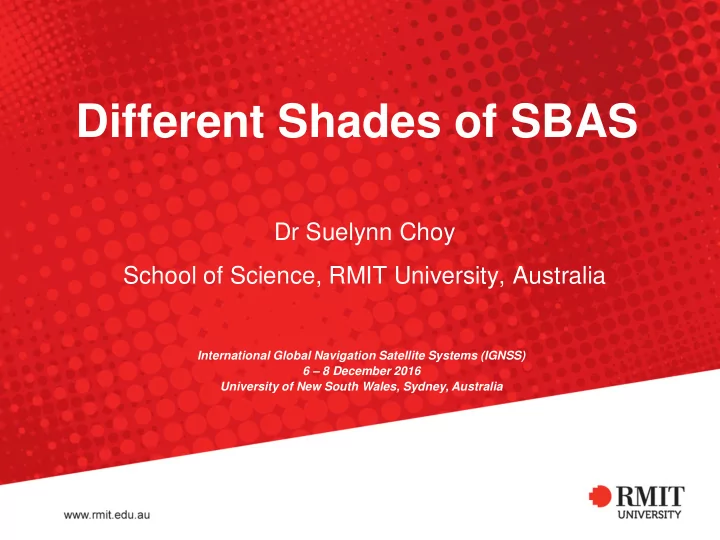

Different Shades of SBAS Dr Suelynn Choy School of Science, RMIT University, Australia International Global Navigation Satellite Systems (IGNSS) 6 – 8 December 2016 University of New South Wales, Sydney, Australia
S. Choy, J. Kuckartz, A. G. Dempster, C. Rizos, and M. Higgins, "GNSS satellite-based augmentation systems for Australia," GPS Solutions, Online First, 2016. IGNSS2016@UNSW,Sydney 2
Purpose 1. Tease out similarities and difference in their augmentation capabilities a. SBAS for aviation b. “ non aviation ” SBAS 2. Present an overview of SBAS options for augmented GNSS services in Australia and New Zealand Note: SBAS – Satellite Based Augmentation System IGNSS2016@UNSW,Sydney 3
What is SBAS? SBAS: Satellite-based Augmentation System SBAS is a civil aviation safety-critical system that supports wide-area or regional augmentation through the use of geostationary satellites Keywords: (1) Civil aviation safety-critical system, ICAO SARPs (2) Augmentation SBAS enhance existing GNSS by mainly providing integrity and improving accuracy ICAO - International Civil Aviation Organisation SARPs - SBAS Standards and Recommended Practices IGNSS2016@UNSW,Sydney 4
What is SBAS? SBAS: Satellite-based Augmentation System SBAS is a civil aviation safety-critical system that supports wide-area or regional augmentation through the use of geostationary satellites “ SBAS for aviation ” Keywords: (1) Civil aviation safety-critical system, ICAO SARPs (2) Augmentation SBAS enhance existing GNSS by mainly providing integrity and improving accuracy ICAO - International Civil Aviation Organisation SARPs - SBAS Standards and Recommended Practices IGNSS2016@UNSW,Sydney 5
SBAS for Aviation SBAS transmits (a) integrity, (b) ranging information, and (c) correction messages: (a) Integrity is enhanced by sending alerts to users to not track the failed satellites identified as having large signal errors. (b) Signal availability is improved as the SBAS satellite transmits additional L1 ranging signal. (c) Accuracy is enhanced through the transmission of wide- area corrections for range errors, such as satellite orbits, clocks, and improved ionospheric information. IGNSS2016@UNSW,Sydney 6
SBAS for Aviation SBAS transmits (a) integrity, (b) ranging information, and (c) correction messages: (a) Integrity is enhanced by sending alerts to users to not SBAS service is available to all users. track the failed satellites identified as having large signal errors. The majority of mass market receivers have (b) Signal availability is improved as the SBAS satellite SBAS capability transmits additional L1 ranging signal. (c) Accuracy is enhanced through the transmission of wide- area corrections for range errors, such as satellite orbits, clocks, and improved ionospheric information. IGNSS2016@UNSW,Sydney 7
Existing SBAS Systems Operational Still to be certified or under development Certified for precision approach (2016) • SDCM (Russia) • WAAS (US) • Beidou SBAS (China) • EGNOS (EU) • KASS (South Korea) Limited to Non-precision approach • SBAS Africa • MSAS (Japan) • Other systems in feasibility phase • GAGAN (India) (GENQ Inc, 2015) IGNSS2016@UNSW,Sydney 8
EGNOS Integrity Accuracy Integrity (Vertical) margins as maximum Accuracy (Vertical) map, 95% Vertical Vertical Safety index map (maximum Position Error in metres. ratio between the vertical user error and the vertical user protection level). (ESA Navipedia, 2011) IGNSS2016@UNSW,Sydney 9
Aviation SBAS for Australia According to a white paper produced by the Australian Space Industry Innovation Council in 2011* ….. Australia could consider a SBAS capability that is: • Solely owned and operated by Australia • An extension of other existing SBAS • A global SBAS model, either implemented as part of a government or commercial arrangement * Australia Department of Infrastructure and Transport (2011) Satellite based augmentation system review. Australian Government. IGNSS2016@UNSW,Sydney 10
Augmented GNSS using Satellite Technology “ Non-aviation ” SBAS Not compliant with aviation requirement: • Differences in data message structures • Different frequencies used for transmission of corrections • Absence of the extra ranging signals from the GEO satellites • Missing integrity data and monitoring differ predominantly in positioning accuracy and targeted applications IGNSS2016@UNSW,Sydney 11
Positioning Accuracy (NovAtel Inc, 2015) IGNSS2016@UNSW,Sydney 12
Commercial “ Non-aviation ” SBAS IGNSS2016@UNSW,Sydney 13
Dual-frequency Multi-constellation Aviation SBAS Dual-frequency GNSS operation: • Increases SBAS availability and performance as it will be robust against ionospheric gradients • Improves robustness against unintentional interference • Support multi-constellation Development: • WAAS Development Phase IV -Dual Frequency Operations. Planned for 2014-2028 (2044) • GSA is conducting activities to support next generation EGNOS IGNSS2016@UNSW,Sydney 14
Dual-frequency GPS-only SBAS Dual-frequency WAAS, EGNOS, MSAS, GAGAN and SDCM coverage (GPS-only) (Walter et al. 2010) IGNSS2016@UNSW,Sydney 15
Dual-frequency GPS-only SBAS Hypothetical expansion of ground stations for WAAS, EGNOS and MSAS into the southern hemisphere Dual-frequency GPS-only SBAS (Walter et al. 2010) IGNSS2016@UNSW,Sydney 16
Dual-frequency Multi-constellation SBAS Current ground stations. GPS+Galileo Expansion of ground stations in Dual-frequency WAAS, EGNOS, the southern hemisphere MSAS, GAGAN and SDCM coverage (Walter et al. 2010) IGNSS2016@UNSW,Sydney 17
Next Generation GNSS/RNSS • New augmentation signals with data transmission channels: SBAS, DGNSS, PPP • MEO and IGSO satellites, in addition to GEO satellites IGNSS2016@UNSW,Sydney 18
Galileo (GSA, 2015) IGNSS2016@UNSW,Sydney 19
QZSS (QSS Inc., 2015) IGNSS2016@UNSW,Sydney 20
Summary • Aviation SBAS: – Civil aviation safety-critical system, ICAO SARPs – Enhance existing GNSS by providing integrity and improving accuracy • Non-aviation SBAS: – Support numerous GNSS PNT applications – Wide-area DGNSS and PPP techniques – Not ICAO compliant • Dual-frequency multi-constellation SBAS brings improved performance, e.g., robust against ionosphere, coverage, interference • Next generation GNSS/RNSS satellites with augmentation capabilities IGNSS2016@UNSW,Sydney 21
Food for Thoughts SBAS consideration for Australia 1. Which SBAS? For aviation or non-aviation applications? • Different users ’ requirements: accuracy, integrity, availability and continuity. E.g., C-ITS, 1m 95%?? 2. Our own SBAS, or can we cooperate? • Existing SBAS and/or next generation GNSS/RNSS 3. What services to provide? SBAS, DGNSS, PPP and/or PPP-RTK? 4. What are the roles of Government and Industry? 5. Would “PPP-like” satellite corrections be provided for free in the future by GNSS/RNSS satellites? • “ Selective unavailability ” IGNSS2016@UNSW,Sydney 22
Recommend
More recommend